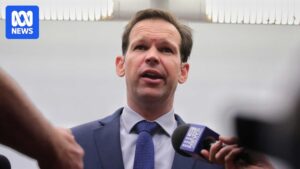
Former Western Bulldogs AFLW coach Nathan Burke has accused the league of heavily influencing player trades to favor expansion clubs, a move he claims has led to a competitive imbalance in the league. Burke’s comments come in the wake of a particularly lopsided round two of the AFLW season, where four out of nine games were decided by margins of 70 points or more.
Burke, who played 323 AFL games for St Kilda before coaching the Bulldogs from 2020 to 2023, argues that the league’s intervention in trades and the tiered payment system have left many clubs struggling to develop effectively. “Many clubs had to try and continue to develop through the 2019, 2020, and 2022 expansions with ‘one hand behind their back,'” Burke remarked, highlighting the challenges posed by the current system.
Trade Restrictions and Expansion Incentives
The AFLW’s trade policies, according to Burke, have been a significant barrier for clubs attempting to maintain competitive rosters. He claims that every trade required league approval, often resulting in rejections if the trade was deemed too advantageous for one team over another. “We had numerous trades that we wanted to do, and the other team agreed to it. Both teams were happy with it, and the AFL were the final arbiter of any trades, and said, ‘No, in our opinion, that other club is not benefiting enough,'” Burke told ABC Sport.
In addition to trade restrictions, Burke alleges that the AFL offered extra incentives to star players to move to expansion clubs, such as ambassador roles and additional services agreements. “I lost players who were contacted by the AFL to say, ‘Hey, we think it would be a good idea if you went to this club,'” Burke stated.
Impact on Teams and Players
The Western Bulldogs, one of the eight foundation AFLW teams established in 2017, won the premiership the following season but were subsequently hit hard by player losses to expansion clubs. In total, the Bulldogs lost 13 key players during the league’s three expansions, including notable names like Monique Conti and Katie Brennan.
Brisbane also faced significant player departures, losing 16 players in just over a year during the first two expansions. The current payment system, which standardizes salaries across all 18 teams through a four-tiered system, has made it difficult for clubs to retain their star players. “If you’ve got a player on tier three who thinks they’re a tier two, well, you’ve got to wait for somebody to leave or vacate that spot,” Burke explained.
Tier 1 players earn $109,760, tier 2 $89,559, tier 3 $76,091, and tier 4 $67,337 for the 2025 season.
Future Prospects and Potential Reforms
AFL executive general manager of football operations Laura Kane has indicated that the league is open to introducing a salary cap. “We have a soft cap, we introduced a national draft last year, and we don’t currently have a salary cap, so we’ve got some levers that are available to us when we’re ready to introduce them,” Kane told ABC Sport.
Former AFLW All-Australian and current commentator Kate McCarthy, who moved from Brisbane to St Kilda in 2020, shared her perspective on the issue. She noted that teams like North Melbourne have been strategic in their list building, but expressed sympathy for clubs like the Western Bulldogs that have struggled to retain their core players. “The Western Bulldogs, they’ve been absolutely raided and haven’t been able to recover from it,” McCarthy said.
With no further expansions expected until Tasmania joins the league, McCarthy believes that drafting will be crucial for teams looking to rebuild. “The other positive for this is how quickly we think draftees can change this competition,” she noted, highlighting the potential for draft talent to quickly impact team performance.
The AFL has been contacted for comment on these allegations and potential reforms.







